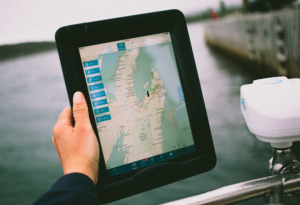If you have ever encountered rough weather conditions such as strong winds that have lead to an unpleasant day on the water, you will understand the importance weather has on sailing. Weather conditions can change rapidly, and even the most experienced skipper can be forced into difficulties if they forgo their due diligence and neglect to understand how weather conditions will unfold.
When planning a passage or heading offshore for several days, having an understanding of what the weather will be like for the duration of your travel is even more critical. You may have sun and cloudless skies when leaving land behind, but that is no guarantee for a smooth journey.
Thankfully, receiving weather forecasts and updating your knowledge of weather conditions is easier and more affordable than ever before thanks to satellite communications and technological advancements. With mazu, cruisers have a host of weather options at their disposal, and can request crucial weather information anywhere in the world. From 7 day wind and wave forecasts to tropical storm outlooks, mazu ensures that cruisers can remain connected and aware of their environment.
One of the most exciting updates that was released this year was the addition of GRIB files to the mazu iPad App. Alongside the versatile weather options mazu offers, sailors and cruisers can now utilize GRIB files to truly enhance their experience out on the water and master the wind.
Unfamiliar with what a GRIB file is, how to read one, or why GRIB is an incredible tool for sailors? Then read on!

What is GRIB?
GRIB stands for GRIdded Binary or General Regularly distributed Information in Binary form. GRIB is a data format that is concise, and is frequently used in meteorological practice for the storage of historical or forecasted weather data. Essentially, GRIB is a data-concise way to store and view weather information, and this is what makes GRIB such an excellent tool for sailors and cruisers.
There are many different forecast models of GRIB, including:
- GFS
- ECMWF
- WW3
- RTOFS
mazu utilizes the WW3 forecasting model for GRIB. As with any GRIB model, it is important to note that GRIB files can serve as valuable weather forecasting tools but are not a guaranteed representation of what weather conditions will be. GRIB forecasts are not reviewed by meteorologists or any other group and the data should be interpreted with this in mind. Sailors and cruisers should use GRIB to assist in their route planning and preparation, as well as to gain an indication of what weather conditions may be like. However, additional weather forecasting tools are also important to use in addition to using GRIB.
In other words, the more weather data you have available, the better!
Reading a GRIB File:
While looking at a GRIB file may seem intimidating at first, deciphering a GRIB file is actually very simple. Knowing how to use wind patterns to your advantage or find a suitable weather window is a different story, but by familiarizing yourself with how to read GRIB data, you can better prepare yourself for future passage making and sailing in general.
Wind Barbs:
An excellent graphic from Grenada Blue Water Sailing shows just how simple it is to decipher GRIB data. Wind barbs indicate both the wind speed and wind direction. The barb line represents wind direction by pointing to the direction where the wind is blowing from. The tails extending from the barb are an indication of wind speed; each half of a tail represents 5 knots of wind. Therefore, in the example below, the wind barb indicates a northwest wind (headed southeast) travelling at 25 knots.
A singular dot or circle within a dot represents calm conditions. A triangle indicates 50 knots of wind. Interpreting GRIB data is as simple as that, yet the information contained in GRIB files can be extremely valuable for cruisers or even day-sailors.
Requesting a GRIB Forecast:
Download GRIB data with mazu can be done easily, and can assist cruisers with finding an adequate weather window and understanding wind patterns. Simply select the GRIB option from the Weather Menu, choose a GRIB boundary, and request the GRIB data. Users can select forecast lengths as low as 6 hours or as long as 7 days, and can use the new mazu GRIB slider to view how weather conditions change in 6 hour intervals.
Watch the video below for a quick how-to guide on using mazu to request, download, and view GRIB files, or head over to the mazu YouTube Channel!
GRIB Viewers:
There are a variety of GRIB viewer programs that allow users to download GRIB files and view the data source in a visual format. However, one of the main advantages of the mazu iPad App is the ability to request, download, and view GRIB files all within the app. Download and save GRIB forecasts and easily access them whenever you require! It is that simple.
Planning a Passage:
One of the most beneficial GRIB features of mazu is the ability to download GRIB files over the internet and save them to your reports. 7 day GRIB forecasts can be downloaded through satellite, but to reduce data usage and lower costs, cruisers can download the weather forecasts they require before departing. While offshore, cruisers can update weather information by downloading smaller sections of GRIB data. Area size options for download include 200, 300, 400, and 500 nautical mile zones.


Utilizing Other Weather Forecasts: The More Data, the Better!
GRIB files can provide sailors and cruisers an understanding of what weather conditions will most likely be. However, obtaining additional weather forecast data can allow for the comparison of weather information and an additional level of certainty. mazu offers a host of useful weather options, including:
- Global wind and wave forecasts (up to 7 days).
- Coastal, offshore, and high seas NOAA zone forecasts (5 days).
- Live buoy data.
- NOAA weather alerts.
- Tropical storm advisory.
- NEXRAD imagery.
The combination of weather options that are utilized is left to the user to decide. Ultimately, by downloading GRIB files and other weather information before departure, cruisers can gain a better understanding of what weather conditions will be like before setting out. By only requesting shorter forecast information or smaller GRIB boundaries while offshore, cruisers can also reduce their overall data consumption and lower monthly costs.
If you want to learn more about the mazu iPad App and how to use GRIB files when sailing, you can download mazu for free on the iPad App Store or read more on our Homepage!


















